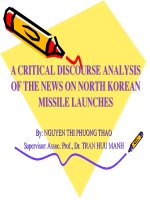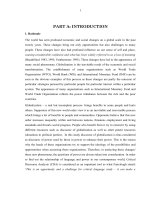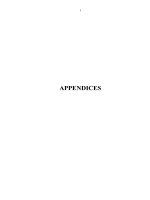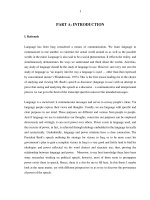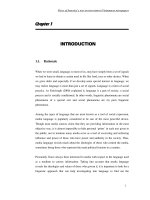A critical discourse analysis of the news on north korean missile launches part 3
Bạn đang xem bản rút gọn của tài liệu. Xem và tải ngay bản đầy đủ của tài liệu tại đây (65.07 KB, 4 trang )
ACKNOWLEDGEMENTS
I am greatly indebted to my teachers, colleagues, friends, and family for their support and
help in the preparation and completion of this paper.
First of all, I would like to express my deepest gratitude to my supervisor, Assoc. Prof., Dr.
Trần Hữu Mạnh for his expert advice, critical and constructive comments, invaluable
suggestions and enthusiastic guidance without which the thesis would not have been
successfully completed.
I also wish to thank all my lecturers at Postgraduate Department, College of Foreign
Languages, Vietnam National University, Hanoi for their concern, lessons and support.
My special thanks go to my colleagues and friends for their helpful comments and useful
materials.
I would like to express my gratefulness to my parents, my husband and my son whose
encouragement, expectation, and assistance helped me overcome all the difficulties in
fulfilling this paper.
i
LIST OF TABLES
Table 1. Names for US-Japan coalition and North Korea in VOA
Table 2. Names for US-Japan coalition and North Korea in Nhan Dan
Table 3. Negativization of North Korea’s activities in VOA
Table 4. Positivization of the US- Japan coalition’s activities in VOA
Table 5. Lexicalization of North Korea’s activities in Nhan Dan
Table 6. Lexicalization of the US-Japan coalition’s activities in Nhan Dan
Table 7. Over-lexicalization of the North Korea’s missile launches in VOA
Table 8. Over-lexicalization of the North Korea’s missile launches in Nhan Dan
Table 9. Quotation patterns of news reports in VOA
Table 10. Quotation patterns of news reports in Nhan Dan
ii
TABLE OF CONTENTS
Acknowledgements ………………………………………………………………………i
List of Tables ……………………………………………………………………………..ii
INTRODUCTION ……………………………………………………………………….1
1. Rationale …………………………………………………………………………..1
2. Scope of the research ……………………………………………………………...2
3. Aims of the research and research questions ……………………………………...2
4. Methodology ………………………………………………………………………3
5. Background information …………………………………………………………..4
6. Design of the research ……………………………………………………………..5
CHAPTER 1 – THEORETICAL BACKGROUND …………………………………...6
1.1. The history of Critical Linguistics and Critical Discourse Analysis ……………..6
1.2. Theories on Critical Discourse Analysis …………………………………………8
1.2.1.What is Critical Discourse Analysis ……………………………………………..9
1.2.2.Key notions of CDA ……………………………………………………………..9
1.2.3.Methodology of CDA ……………………………………………………………11
1.2.4.Principles of CDA ……………………………………………………………….12
1.3. Systemic Functional Linguistics and its role in CDA …………………………...13
1.4. CDA in relation with Cultural Studies …………………………………………...13
CHAPTER 2 – METHODOLOGY …………………………………………………….15
2.1. Data ……………………………………………………………………………...15
2.1.1. Data sources
……………………………………………………………………..15
2.1.1.1. Voice Of America
……………………………………………………………….15
2.1.1.2. Nhan Dan
………………………………………………………………………..16
iii
2.1.2. Data selection and sampling
…………………………………………………….17
2.2. Analytical framework …………………………………………………………...17
2.3. Method of analysis ………………………………………………………………19
2.3.1. Analyzing headlines
……………………………………………………………..19
2.3.2. Analyzing full-text news reports
………………………………………………...20
CHAPTER 3 – DATA ANALYSIS AND DISCUSSION ……………………………..21
3.1. Analysis of headlines ……………………………………………………………21
3.1.1.Voice Of America ……………………………………………………………….22
3.1.2.Nhan Dan ………………………………………………………………………..24
3.2. Analysis of full-text news reports ……………………………………………….26
3.2.1.Naming referents ………………………………………………………………...27
3.2.1.1.VOA ……………………………………………………………………………..27
3.2.1.2.Nhan Dan ………………………………………………………………………..29
3.2.2.Lexicalization ……………………………………………………………………31
3.2.2.1.VOA ……………………………………………………………………………..31
3.2.3.Nhan Dan ………………………………………………………………………...35
3.2.4.Over-lexicalization ………………………………………………………………36
3.2.4.1.VOA ……………………………………………………………………………..36
3.2.4.2.Nhan Dan ………………………………………………………………………...38
3.2.5.Quotation patterns ……………………………………………………………….39
3.2.5.1.VOA ……………………………………………………………………………..39
3.2.5.2.Nhan Dan ………………………………………………………………………...42
CONCLUSION …………………………………………………………………………..45
1. A summary of the findings ………………………………………………………..45
2. Suggestions for further research …………………………………………………..47
REFERENCES …………………………………………………………………………..48
iv
APPENDICES
v




